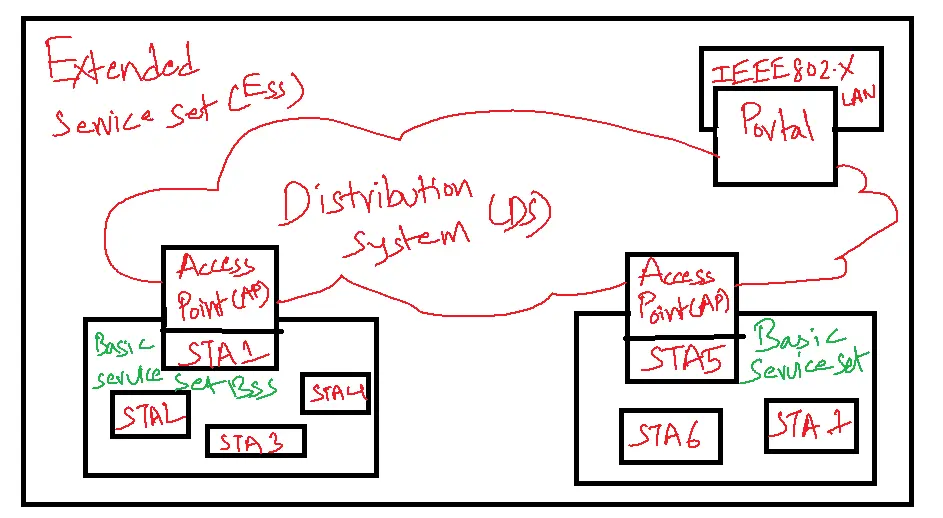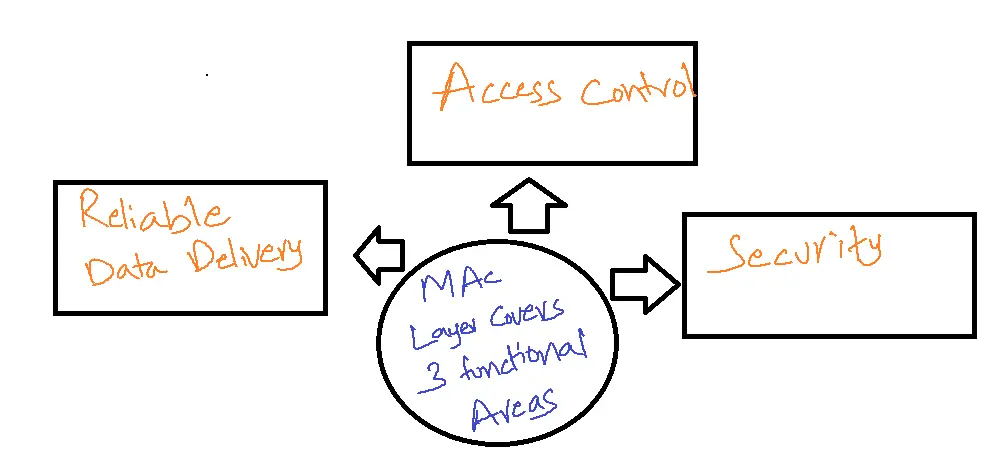- IEEE 802.11 is a set of standards for wireless local area networks (WLANs) developed by the Institute of Electrical and Electronics Engineers (IEEE).
- It defines the protocols and technologies for wireless networking, enabling devices to connect and communicate without cables.
- IEEE means Institute of Electrical and Electronics Engineers, Engineers in electronics, computers, and communications make up the membership of IEEE, an international professional association established in the United States. With more than 200,000 members, it is currently the largest professional society in the world.
- Its goal is to drive progress in electrical engineering by setting standards that foster theoretical understanding, innovation, and the creation of high-quality products.
- It is a new working group dedicated to wireless LANs and was established by the IEEE 802 Committee in 1990. Its mission was to provide a physical medium standard and MAC protocol.
Key Components of IEEE 802.11
1. Frequency Bands: It operates on two frequency bands: 2.4 GHz and 5 GHz.
2. Data Transfer Rates: It supports various data transfer rates, ranging from 1 Mbps to 9.6 Gbps.
3. Network Topology: It supports two network topologies: infrastructure and ad-hoc.
4. Security Protocols: It includes protocols like WEP, WPA, and WPA2 to ensure secure data transmission.
| Standard | Scope |
| IEEE 802.11a | Physical Layer: 5-GHz OFDM at rates from 6 to 54 Mbps |
| 802.11b | Physical Layer: 2.4-GHz DSSS at 5.5 and 11 Mbps |
| 802.11c | Bridge Operation at 802.11 MAC Layer |
| 802.11d | Physical Layer: Extended operation of 802.11 WLANs to new regulatory domains |
| 802.11e | MAC: Enhance to improve quality of service and enhance security mechanisms. |
| 802.11g | Physical Layer: Extended 802.11b to data rates > 20 Mbps |
| 802.11i | MAC: Enhance security and authentication mechanisms |
| 802.11n | Physical/MAC: Enhancements to enable higher throughput |
| 802.11T | Recommended practice for the evaluation of 802.11 wireless performance |
| 802.11ac | Physical/MAC: Enhancement to support 0.5-1 Gbps in 5-GHz band |
| 802.11 ad | Physical/MAC: Enhancement to support ≥1 Gbps in 60-GHz band |
IEEE 802.11 Architecture and Services

- A basic service set, or BSS, is a group of stations that compete to use a shared wireless medium while executing the same MAC protocol. An AP is not involved in an IBSS (independent BSS), usually an ad hoc network.
- A BSS can be isolated or connected to a backbone distribution system (DS) through an access point (AP). In a BSS, client stations do not communicate directly with one another.
- A distribution system connects two or more basic service sets to form an extended service set (ESS).
- A porta combines the IEEE 802.11 architecture with a conventional cable LAN.
Table of Contents
IEEE 802.11 Operating Modes
- 802.11 Infrastructure Mode at least one wireless AP and one wireless client.
- Ad Hoc Mode 802.11 allows wireless clients to speak with one another directly without the call for a wireless access point.
IEEE 802.11 Terminology
- Service data units (SDUs) are the input for every layer.
- Protocol data units (PDUs) are the output for each layer, which is used to interact with the corresponding layer at the other end.
- SDUs can be combined or divided to create PDUs. PDUs contain a header unique to the layer.
Association-Related Services
- DS requires information about stations within the ESS that utilize association-related services.
- The station must be connected for DS to send or receive data.
- A mobile station can move from one BSS to another by using reassociation, which allows an established association to be transferred from one AP to another.
- Disassociation is the notification from either a station or an AP that an existing association is terminated.
- Association stations are required to establish an association with an AP within a specific BSS. The AP can then communicate this information to other APs within the ESS to facilitate routing and delivery of addressed frames.
| Services | Provider | Used to Support |
| Association | Distribution System | MSDU Delivery |
| Authentication | Station | LAN Access and Security |
| deauthentication | Station | LAN Access and Security |
| Disassociation | Distribution System | MSDU Delivery |
| Distribution | Distribution System | MSDU Delivery |
| Integration | Distribution System | MSDU Delivery |
| MSDU Delivery | Station | MSDU Delivery |
| Privacy | Station | LAN Access and Security |
| Reassociation | Distribution System | MSDU Delivery |
IEEE 802.11 Medium Access Control

- 802.11’s physical and MAC layers are unreliable
- Noise, interference, and other propagation effects cause a significant number of frames to be lost
- The problem can be resolved at a higher layer, like TCP
- Retransmission times at higher layers are usually measured in seconds
- MAC errors are more effectively handled at the MAC level
- 802.11 includes frame exchange protocol
- stations that receive frames return acknowledgment (ACK) frames
- exchanges are treated as atomic units
- retransmit if no ACK is received quickly.
Advantages of IEEE 802.11
1. Convenience: It enables wireless connectivity, making it easy to move devices around.
2. Flexibility: It supports various devices and applications.
3. Cost-Effective: It reduces the need for cables and infrastructure.
Disadvantages of IEEE 802.11
1. Interference: These signals can be disrupted by other wireless devices.
2. Security Risks: These networks can be vulnerable to hacking and eavesdropping.
3. Range Limitations: Signals are limited and can be affected by physical barriers.
Applications of IEEE 802.11
1. Wireless Internet Access: It enables wireless internet access in homes, offices, and public hotspots.
2. Wireless Networking: It connects devices in a wireless network, enabling file sharing and communication.
3. Internet of Things (IoT): connects IoT devices, enabling smart homes and cities.
Conclusion
IEEE 802.11 is a widely adopted standard for wireless networking, offering convenience, flexibility, and cost-effectiveness. While it has limitations, it remains a crucial technology for wireless communication, driving innovation and connectivity in various industries.
FAQs
1. What is IEEE 802.11?
- It is a set of technical standards that define the protocols for wireless local area networks (WLANs), commonly known as Wi-Fi.
- The physical (PHY) and medium access control (MAC) layers in wireless networks adhere to the specifications laid out in this standard.
2. What are the different IEEE 802.11 standards?
- The original standard has evolved through multiple versions and amendments, each offering enhancements in data rates, range, and functionality.
- The most common ones include 802.11a, 802.11b, 802.11g, 802.11n, 802.11ac, and 802.11ax (Wi-Fi 6).
3. What frequency bands does IEEE 802.11 operate on?
- This type of IEEE network primarily operates in the 2.4 and 5 GHz frequency bands. Some newer standards, like 802.11ad and 802.11ay, also utilize the 60 GHz band for high-speed, short-range communication.
4. What are the key benefits of using IEEE 802.11 (Wi-Fi)?
- Wireless Connectivity: Provides convenient, cable-free access to networks and the internet for various devices.
- Mobility: Allows users to move freely within the network coverage area while remaining connected.
- Scalability: Can be easily expanded to accommodate more users and devices.
- Cost-effectiveness: Eliminates the need for extensive cabling, reducing installation and maintenance costs.
5. What are the potential challenges with IEEE 802.11?
- Interference: Susceptible to interference from other wireless devices and appliances operating in the same frequency band.
- Security: Wireless networks can be vulnerable to unauthorized access and data breaches if not properly secured.
- Range Limitations: Obstacles, distance, and environmental conditions can impact the strength and reach of the signal.
